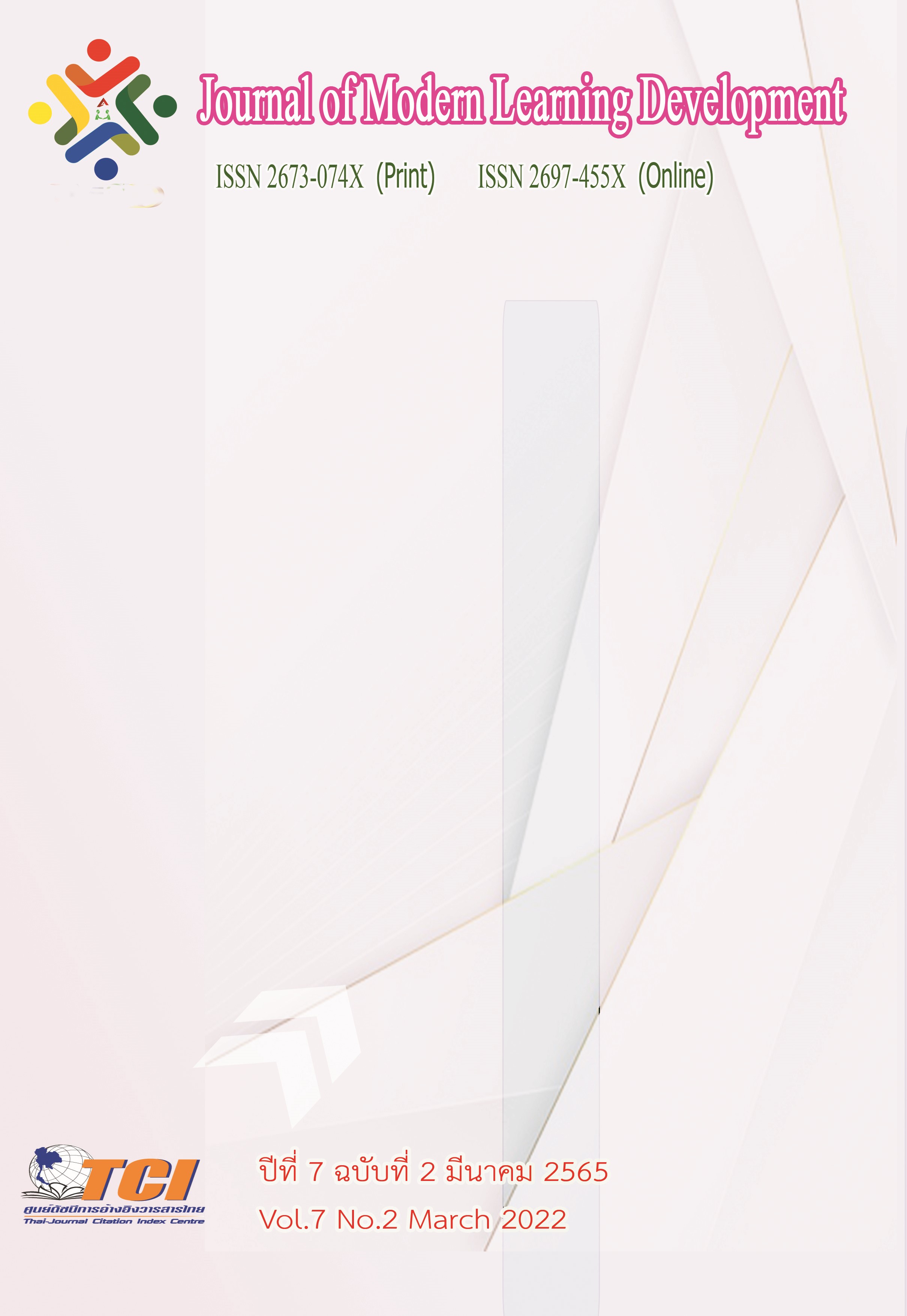The Role Model of the Government and Private Sectors in Promoting Agricultural Trade Case Study of Fruit Trade in the Upper South of Thailand
Main Article Content
Abstract
The purposes of the study were 1) to investigate the level of the government and private roles, 2) to study the level in enhancing agricultural products, 3) to study relationship and investigate equation factors effecting to the government and private roles in enhancing agricultural products, 5) to create patterns of the government and private roles in enhancing agricultural products; the case study of the upper south of Thailand. The research was the mixed method between quantitative method and qualitative method. The participants were 400 people which using formula of Taro Yamane to calculate a sample size. The questionnaire was chosen to be the main instrument. The statistic used were the frequency distributions, mean, average, standard deviation, hypothesis testing, Pearson’s Correlation Coefficients, a statistically significant level. 05, Multiple Linear Regression by Stepwise at a statistically significant level. 01. There were 2 methods for collecting the data for the quantitative research; the in-depth interview was used to collect from 18 people by using the purposive sampling method, and the sub group meeting was collecting data from 18 people by using the purposive sampling method. The discussion of the research result was presented through the description and explanation.
The results shown that 1) the level of the government and private roles was in the medium level, 2) the level in enhancing agricultural products was in the medium level, 3) the relationship between the government and private roles with enhancing agricultural products was overall in the high level at .837, 4) equation factors effecting to the government and private roles in enhancing agricultural products; the case study of the upper south of Thailand arranging through the equation orderly as follow; the factor of creating activities for enhancing selling and the factor of presenting products (X8), the factor of developing the quality of products (X6), and the factor of offering customer service (X4). Moreover, the last variable of the Multiple Linear Regression was the factor of creating strength of the local (X3) which the equation can be written in a standard as follow;
Unstandardized score = .370 +.178X3 + .192X4 + .203X6 + .307X8
Standardized score = .382Z8 + .231Z6 +.208Z4 +.208Z3
5) The patterns of the government and private roles in enhancing agricultural products; the case study of the upper south of Thailand included the factor of creating the strength of the local, the factor of offering customer service, the factor of developing the quality of products, the factor of marketing, the factor of developing the potential of entrepreneurs, the factor of supporting the export system, the factor of creating the network of trading the factor of the good management (Good governance and Corporate Governance), the factor of advanced technology, the factor of the leaders who have good visions, and the factor of the corporation of the government and private roles in enhancing agricultural product; the case study of the upper south of Thailand.
Article Details
References
กรมส่งเสริมการส่งออก กระทรวงพาณิชย์. (2559). การสร้างมูลค่าเพิ่ม. ออนไลน์. สืบค้นเมื่อ 25 ธันวาคม 2562. แหล่งที่มา: https://valuecreation.ditp.go.th/
ไชยรัฐ เจริญสินโอฬาร. (2553). รัฐ-ชาติ (ความไร้) ระเบียบโลกชุดใหม่. (พิมพ์ครั้งที่ 2). กรุงเทพมหานคร: วิภาษา.
นาตยา พุ่มเรือง. (2559). บทบาทภาครัฐและภาคเอกชนในการพัฒนากลยุทธ์การค้าตลาดชายแดนไทย - เมียนมาร์ (ด่านสิงขร) จังหวัดประจวบคีรีขันธ์. วิทยานิพนธ์ปริญญารัฐประศาสนศาสตรมหาบัณฑิต สาขาวิชารัฐประศาสนศาสตร์. บัณฑิตมหาวิทยาลัย: มหาวิทยาลัยราชภัฏเพชรบุรี.
บรรจง กาญจนานิล. (2559). บทบาทของรัฐในการพัฒนาเขตเศรษฐกิจพิเศษ : กรณีศึกษาเขตเศรษฐกิจพิเศษตราด.วารสารรัชตภาคย์ มหาวิยาลัยรัชตภาคย์. 12 (26), 78-89.
บีบีซีนิวส์. (2561). รัฐบาลไทยฝันเป็นศูนย์กลางผลไม้โลก นักวิชาการแนะแก้ปัญหา ล้งจีน” ให้ได้ก่อน. ออนไลน์. สืบค้นเมื่อ 20 มีนาคม 2563. แหล่งที่มา: https://www.bbc.com/ thai/thailand-42941461
พิมลรัตน์ คำบอล. (2554). การบริหารจัดการมังคุดในภาคตะวันออก: กรณีศึกษากลุ่ม ปรับปรุงคุณภาพมังคุดตรอกนอง ตำบลตรอกนอง อำเภอขลุง จังหวัดจันทบุรี. ศูนย์วิจัยเพื่อการเกษตรและสหกรณ์การเกษตร นครราชศรีธรรมราช.
ภวานี เผือกบัวขาว. (2560). รูปแบบการกำหนดนโยบายส่งเสริมการค้าชายแดนไทย-เมียนมา จังหวัดประจวบคีรีขันธ์ ผลการวิจัยพบว่า ปัญหาการกำหนดนโยบายส่งเสริมการค้าชายแดนไทย-เมียนมา จังหวัดประจวบคีรีขันธ์. วารสารศิลปกร มหาวิทยาลัยศิลปกร. 10 (3), 68-85.
วสันต์ กู้เกียรติกูล. (2545). ระบบส่งเสริมการเกษตร จังหวัดยะลา.รายงานวิจัย มหาวิทยาลัยราชนครินทร์ วิทยาเขตหาดใหญ่.
วัชรินทร์ สุทธิศัย, สิทธิพรร์ สุนทร และคณะ. (2563). ปัจจัยที่มีอิทธิพลต่อขวัญกำลังใจในการปฏิบัติงานของบุคลากรองค์การบริหารส่วนตำบลในพื้นที่กลุ่มจังหวัดภาคตะวันออกเฉียงเหนือตอนบน 1 ของประเทศไทย. วารสารเซนต์จอห์น มหาวิทยาลัยเซ็นต์จอห์น. 33 (23),37-38.
สำนักงานเกษตรและสหกรณ์จังหวัดนครศรีธรรมราช. (2562). ฐานข้อมูลรายสินค้า (มังคุด). รายงานประจำปีฐานข้อมูลเกษตรรายสินค้า จังหวัดนครศรีธรรมราช ประจำปีงบประมาณ พ.ศ.2562
สุปรีชา ชำนาญพุฒิพร. (2558). ประสิทธิผลการนำนโยบายยางพาราไปปฏิบัติของสถาบันเกษตรกรยางพาราในจังหวัดภาคใต้ตอนบน. วิทยานิพนธ์ หลักสูตรรัฐประศาสนศาสตรดุษฎีบัณฑิต สาขาวิชารัฐประศาสนศาสตร์. บัณฑิตมหาวิทยาลัย: มหาวิทยาลัยราชภัฏวไลยอลงกรณ์ ในพระบรมราชูปถัมภ์ จังหวัดปทุมธานี.


